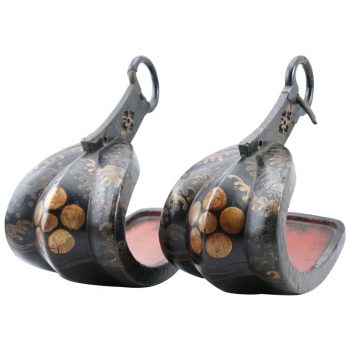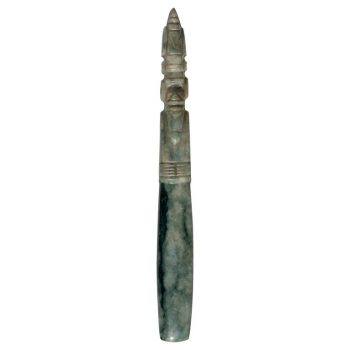Description
Ayutthaya Lacquered and Gilt Copper Bronze Buddha Head Circa 15th Century
A beautifully lacquered and gilt bronze Buddha head from the Kingdom of Ayutthaya, Thailand, circa 15th century.
The Buddha’s face has a distinct Khmer influence, with a square face and jaw, broad nose, and long straight lips curled up ever so slightly at the edges, in the beginnings of a knowing smile. The Buddha stares unflinchingly outwards from almond shaped eyes and slightly arched brows. Small ears with long pierced lobes frame his face. The hair is arranged in neat rows of tight curls or snails, surmounted by a broad ushnisha, and topped by a large flame finial. The head, originally part of a larger sculpture, and now missing much of the back of the head, was originally gilt, with small traces remaining to the flame finial and areas of the face. Overall with a beautiful and complex patina of mottled greens, browns and reds. Bronze
Height: 7-1/2 inches. Diameter: 3.75 Inches With carved fitted wood stand: 10.3 Inches
Condition: Ancient with losses and wear commensurate of age and use.
AVANTIQUES is dedicated to providing an exclusive curated collection of Fine Arts, Paintings, Bronzes, Asian treasures, Art Glass and Antiques. Our inventory represents time-tested investment quality items with everlasting decorative beauty. We look forward to your business and appreciate any reasonable offers. All of our curated items are vetted and guaranteed authentic and as described. Avantiques only deals in original antiques and never reproductions. We stand behind our treasures with a full money back return policy if the items are not as described.
The Historic City of Ayutthaya, founded in 1350, was the second capital of the Siamese Kingdom. It flourished from the 14th to the 18th centuries, during which time it grew to be one of the world’s largest and most cosmopolitan urban areas and a center of global diplomacy and commerce. Ayutthaya was strategically located on an island surrounded by three rivers connecting the city to the sea. This site was chosen because it was located above the tidal bore of the Gulf of Siam as it existed at that time, thus preventing attack of the city by the sea-going warships of other nations. The location also helped to protect the city from seasonal flooding. The city was attacked and razed by the Burmese army in 1767 who burned the city to the ground and forced the inhabitants to abandon the city. The city was never rebuilt in the same location and remains known today as an extensive archaeological site. At present, it is located in Phra Nakhon Si Ayutthaya District, Phra Nakhon Si Ayutthaya Province. The total area of the World Heritage property is 289 ha. Once an important center of global diplomacy and commerce, Ayutthaya is now an archaeological ruin, characterized by the remains of tall prang (reliquary towers) and Buddhist monasteries of monumental proportions, which give an idea of the city’s past size and the splendor of its architecture. Well-known from contemporary sources and maps, Ayutthaya was laid out according to a systematic and rigid city planning grid, consisting of roads, canals, and moats around all the principal structures. The scheme took maximum advantage of the city’s position in the midst of three rivers and had a hydraulic system for water management which was technologically extremely advanced and unique in the world. The city was ideally situated at the head of the Gulf of Siam, equi-distant between India and China and well upstream to be protected from Arab and European powers who were expanding their influence in the region even as Ayutthaya was itself consolidating and extending its own power to fill the vacuum left by the fall of Angkor. As a result, Ayutthaya became a center of economics and trade at the regional and global levels, and an important connecting point between the East and the West. The Royal Court of Ayutthaya exchanged ambassadors far and wide, including with the French Court at Versailles and the Mughal Court in Delhi, as well as with imperial courts of Japan and China. Foreigners served in the employ of the government and also lived in the city as private individuals. Downstream from the Ayutthaya Royal Palace there were enclaves of foreign traders and missionaries, each building in their own architectural style. Foreign influences were many in the city and can still be seen in the surviving art and in the architectural ruins. The Ayutthaya school of art showcases the ingenuity and the creativity of the Ayutthaya civilization as well as its ability to assimilate a multitude of foreign influences. The large palaces and the Buddhist monasteries constructed in the capital, for example at Wat Mahathat and Wat Phra Si Sanphet, are testimony to both the economic vitality and technological prowess of their builders, as well as to the appeal of the intellectual tradition they embodied. All buildings were elegantly decorated with the highest quality of crafts and mural paintings, which consisted of an eclectic mixture of traditional styles surviving from Sukhothai, inherited from Angkor, and borrowed from the 17th and 18th century art styles of Japan, China, India, Persia and Europe, creating a rich and unique expression of a cosmopolitan culture and laying the foundation for the fusion of styles of art and architecture popular throughout the succeeding Rattanakosin Era and onwards. Indeed, when the capital of the restored kingdom was moved downstream and a new city built at Bangkok, there was a conscious attempt to recreate the urban template and architectural form of Ayutthaya. Many of the surviving architects and builders from Ayutthaya were brought in to work on building the new capital. This pattern of urban replication is in keeping with the urban planning concept in which cities of the world consciously try to emulate the perfection of the mythical city of Ayodhaya. In Thai, the official name for the new capital at Bangkok retains “Ayutthaya” as part of its formal title.





